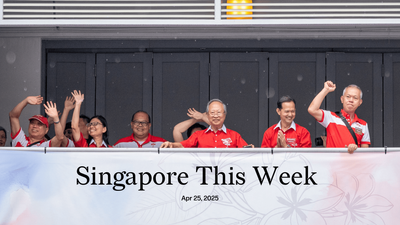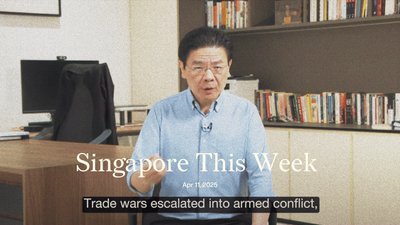Politics: Joshua Raj Thomas, and the PAP’s desperate search for candidates
For the past two decades, it’s become progressively harder for the ruling People’s Action Party (PAP) to attract candidates. Reasons for this include the growing, social media-fuelled scrutiny of politicians’ personal lives, and the increased attractiveness of opposition parties to would-be candidates. Singaporeans should cheer this diffusion of talent across society. Yet PAP fans might lament the dwindling of talent within: the Ivan Lim fiasco at the 2020 general election (GE) suggested the party is not simply scraping the bottom of the barrel, but peeking below it. A related trend is the rise of one- and two-term members of Parliament (MPs), the latest possibly being Ng Ling Ling, first elected in 2020, who did not confirm that she’ll be running again this year. No longer can Singaporeans be assured that new PAP candidates are committed to politics for the long term.
The PAP appears like it’s been forced to recruit from the same old buckets: parachuting in military men; and headhunting civil servants. Singapore has never cared much about maintaining a proper separation between politics and the civil service, with Lawrence Wong, prime minister, a case in point. The PAP’s army-civil service-Temasek nexus is essential to the functioning of the “administrative state”, fans might suggest; terribly insular and sclerotic in a changing world, opponents might retort.
This incestuousness has reached new heights ahead of GE2025. Last month Joshua Raj Thomas and Syed Harun Alhabsyi resigned as nominated members of Parliament (NMPs), fuelling speculation that they might run. Nicholas Fang, a former NMP, and Walid Abdullah, associate professor of political science at NTU, penned Facebook editorials criticising any such crossover, saying it would damage the institution, which was initiated by the PAP precisely to inject non-partisan views into Parliament. (Disclosure: Fang assists Jom with media strategy, and Walid has endorsed us.) “Technically, of course a former NMP can become a MP. But in essence, that would be violating the spirit of having NMPs,” wrote Walid. “I fear that people would—rightly—view future NMPs with some suspicion, and doubt whether they are serving as NMPs with one eye on being future MPs, if such a precedent is set.”
To heck with all that. This week Thomas confirmed that he’s applied to join the PAP, the first-ever NMP to enter partisan politics. He suggested that he had acted ethically—because he no longer felt “neutral”, he resigned so as to “preserve the institution”—but really only confirmed the shallowness and malleability of his earlier vows. Thomas has in Parliament been an articulate regurgitator of PAP talking points, once stridently defending the lack of asset declarations by politicians here (and this week bizarrely praising its handling of the mooted Income-Allianz deal). He’ll slot right in. Notwithstanding Thomas’s calibre, that the PAP would risk devaluing its own NMP scheme is the clearest sign yet of its recruitment desperation.
Politics: Leegacy
Just a few months after politicians swamped us with inanities on the centennial of Lee Kuan Yew’s birth, they were at it again this week, on the 10th anniversary of his death. Amidst the monsoon surge last week, Wong reminded us that it also rained at Lee’s funeral, and called on Singaporeans to “forge a brighter future worthy of the foundation he laid”. Lee Hsien Loong, senior minister and the elder son, reshared Wong’s post, with a few additions, including, “To me and my family, he was our father or grandfather, and meant the world to us.” Clearly so did his house, at 38 Oxley Road. Lee Hsien Yang, the younger son who’s estranged from his brother and wants the house demolished, railed against the present government’s indecisiveness in dealing with the issue.
Indranee Rajah, minister in the prime minister’s office and part of the late Lee’s Tanjong Pagar team, led a team of politicians in laying flowers around the decade-old, “Lee Kuan Yew Memorial Tree”. Indranee used the occasion to parade Rachel Ong, an MP whose (likely vulnerable) West Coast districts have just been gerrymandered into the Tanjong Pagar stronghold. Lee’s ghost might have appreciated Indranee’s use of “pink and white flowers”, some of his favourites, though he might also remember how, when the Oxley saga first broke, she insinuated that he, a fellow lawyer, may not have fully understood his will. Weather will shift, trees will be chopped and replanted, and our reminiscences of people are also always up for opportunistic renewal, perhaps this is the Singapore way.
Alvin Tan, minister of state for culture, community and youth, had the “tribute” with the most decidedly political agenda. He shared a video of a fiery Lee, warning against dishonest opposition figures, which ended with a short snippet of Pritam Singh, WP chief. Tan said he will run again “[t]o deny charlatans the opportunity to destroy what generations of PAP leaders have built over 60 years.”
Minutes before, Singh himself had channelled the Lee of his choosing (with a reference to a 1970 book, shown with tattered library card revealing notable borrowers). In 1968, after having monopolised Parliament, Lee and comrades worried that the political system would be “distorted” and would decline “in stature” without a “loyal opposition”, which they sought to foster. In his paean to the “incredible leader” who “campaigned for a multi-racial Singapore”, Singh studiously avoided any trenchant criticism of Lee’s policies or actions, including his relentless demonisation (and occasional detention) of numerous critics in the 1960s-80s, including JB Jeyarentam, a WP predecessor. Singh committed to being part of a “loyal opposition” in this upcoming GE. It would appear that the path to glory, for any party, remains through this cherry-picked deification of ah gong.
Some further reading: In “Why always LKY?”, Jom argues that Singapore must keep interrogating Lee’s complexities.
Sign up for Jom’s weekly newsletter
Our newsletters combine weekly updates about Singapore with a “build-in-public” narrative, in which we tell readers about our start-up journey.
No spam. Unsubscribe anytime.
Society: The many visions of Tay Kheng Soon
Spend an evening with Tay Kheng Soon, and he may tell you about the time Kwa Geok Choo wagged a finger at hubby Lee Kuan Yew. Or when a co-operative that included Tommy Koh, current establishment doyen, and him, was denied a licence to run a rival newspaper to The Straits Times (ST). He may take you back to the month a “psychologically distraught” Lee spent holed up in a Changi Point bungalow after Singapore had been evicted from Malaysia.
But Tay isn’t merely a first-rate jiang gu (讲古), the master storytellers of yore so adept at recreating worlds long gone. At this week’s “Jom cakap”, the architect and author traced Singapore’s trajectory from the time Lee realised that the lack of a hinterland would make his newly-independent nation a “slave” to the Anglo-American world order. Singapore ports welcomed American ships fighting in Vietnam; its airfields opened up to American jets bombing the country and its refineries fuelled the war effort. S Rajaratnam, then minister for foreign affairs, recast this slavery to project Singapore as a “global city” with “the world as our hinterland”.
The global city needed a quiescent population to become a cog in the neoliberal wheel. Dissent and dissidents dwindled. The government became the sole arbiter and purveyor of ideas. When the Singapore Planning and Urban Research (SPUR) group, co-founded by Tay in 1965, publicly opposed plans to expand Paya Lebar airport to better serve the global city, it got an equally public shellacking. Eventually, SPUR’s view that a new airport be built at the Changi airfield instead prevailed, but after “a decent period of burial” such that it could be claimed by the government as its own. “There are insiders and outsiders in our system…and outsiders are always brushed off,” he said. This divide has only hardened in the years since, possibly to the state’s detriment. “I think the present power elite are going through [a] transition…to swing the big hatchet very publicly [against outsiders] may be out of tune with the new requirements.”
Meanwhile, a larger transition, from the Anglo-American world order to a still nebulous one, is also afoot. “Regionalisation,” or a reclaiming of our archipelagic identity will be vital in navigating this new world, and in softening Singapore’s “arrogant” image among neighbours. Tay’s ideas include vertical take-off aircraft that link the region’s small towns and villages, an NTU “campus city” that hosts entrepreneurs from across South-east Asia, and a medical ship that goes around helping impoverished folks along coastal areas. We can “do well by doing good,” he concluded.
Note: Tay Kheng Soon’s latest book, The Future of Singapore?, is available in all major bookstores including Book Bar, where he spoke to Jom’s subscribers.
Society: Bo Ch(i)ap
Chia Boon Teck might have come a long way from “Commando to a CID investigator to a Singapore Airlines cabin crew before settling down as a lawyer,” but how the mighty have fallen. Days after his egregious comments on LinkedIn about a rape survivor roused fury online and were roundly condemned by the legal fraternity and women’s rights advocates, Chia was asked to resign as vice president and council member of the Law Society of Singapore; requests to which the criminal lawyer, co-managing director of Chia Wong Chambers and grassroots member obliged. The offending post, since removed but not before it was screenshot and shared widely, consisted of 10 questions about the details of the case, which The Peak’s Zat Astha likened to a “manual in victim blaming”.
Chia’s post was a response to a media report after a judge convicted Lev Panfilov, a permanent resident originally from Russia, of two counts of rape, one count of sexual assault by penetration, and one count of outrage of modesty. In a Facebook post, K Shanmugam, home affairs and law minister, observed that Chia had “in effect” suggested that the female victim should not be believed. This despite the High Court having found the rape survivor “an unusually convincing witness”, whose evidence was “internally and externally consistent”. Writing that he was “surprised” to read Chia’s comments, Shanmugam indicated that he didn’t share Chia’s views “philosophically”. Critics online noted that Shanmugam used a far more pleasant tone with Chia than with the two young women activists who had attempted to speak with him about POFMA at his meet-the-people session. Perhaps this was just the way lawyers “respectfully” chat with each other. Chia’s long history as a government grassroots leader might have also shielded him from more widespread condemnation from the establishment. Finally, Chia’s excess was probably unwelcome for the PAP’s anti-woke agenda. Shan’s admonishment of him could be viewed as a point for the other side in the “culture wars”.
“The only person to blame for a rape is the rapist,” declared the Association of Women for Action and Research (AWARE) who on Instagram voiced disappointment that Chia had relied “on rape myths to imply” that a survivor of rape had consented to sex. “A woman’s character, clothing, profession, and dating history,” AWARE reiterated, “should not be used to excuse a sexual assault.” Chia hasn’t apologised for his offensive post yet. Until he does, it’s hard to believe that he’s genuinely contrite about the harmful impact of his words, no matter his asserted intentions for writing them.
Society: Wellness session with Ms ChatGPT
“I know ChatGPT is an AI bot, but it makes me feel heard and validates my feelings more than any human does sometimes,” Jessica, a 25-year-old Singaporean, told South China Morning Post. She described the generative AI chatbot as a space where one can “trauma dump without worrying” and “rant or talk about one thing and end the conversation without feeling the pressure of continuing the conversation since it’s not a real person.”
More young adults are turning to AI chatbots for emotional support, possibly because barriers such as high costs, long waiting times, and stigmatisation are limiting their access to traditional mental healthcare services. This is worrying considering that one in three youths (between 15 and 35 years old) are facing mental health issues. More than half of young adults (between 21 and 35 years old) are likely to report higher levels of social isolation and loneliness and, separately, prefer to communicate online as they sometimes feel anxious talking to people in person.
Could this be a repercussion of the growing “therapy speak”? Terms such as “triggered”, “boundaries”, “gaslighting”, and “trauma dumping” are injected into our everyday vernacular, leading to normal everyday experiences being “over-medicalised”. Incorrect use of such terms can be harmful especially when discussion of establishing healthy boundaries is reduced into self-care templates of “thank you for reaching out but I don’t have the capacity to hold space”. Perhaps our productivity-within-consumerist culture has altered our views on asking for a favour (such as a listening ear) and made us worse friends? “When you’re used to paying people for services [for instance through Grab], every act of help feels like a payment should be involved,” said Mina Le, in her commentary on the loneliness epidemic. Your midnight heart-to-heart call with your bestie is now an activity reserved for your therapist, who is paid by the hour.
Although AI chatbots are undeniably accessible—free, instantaneous, and non-judgmental—they are meant to complement and not replace therapy, even those designed to provide mental health support. AI chatbots’s tendency to “hallucinate” and offer inaccurate information may be detrimental to those facing complex and urgent mental health issues. More importantly, having a community of close friends and confidants can significantly improve one’s mental health well-being. One way to help foster this is through better work-life balance policies. How can we hang out with our friends if we are working beyond office hours?
Earth: Going against the grain
Rice, a staple for half of the world’s population (mostly in Asia), is also a major contributor to climate change. Its cultivation contributes about 10-12 percent of global methane emissions, a powerful greenhouse gas responsible for accelerating global warming. It’s a vicious cycle, for climate change and, consequently, extreme weather patterns are threatening Asia’s rice bowl. Creeping temperatures and droughts are drying up paddy fields, while frequent floods are wiping them out, reducing Asia’s rice productivity growth. This comes amid surging global demand for what’s considered the world’s most important crop, predicted to rise 30 percent by 2050.
A Singaporean project, “Decarbonising Rice”, by researchers at Temasek Life Sciences Laboratory, aims to mitigate the damage, by combining sustainable water management techniques; soil microbiome enhancement; and the development of climate-resilient rice varieties. Irrigation, crucial in rice cultivation, is highly water-intensive. But climate-resilient rice varieties, like the hardy Temasek Rice, can survive for a fortnight without water, producing and, hence, releasing less methane. Drip irrigation is used in trials, allowing rice roots to receive the optimal amount of water, removing the traditional practice of flooding fields, meant to control weeds, which play a significant role in methane production (due to anaerobic decomposition of organic material). Rice is also grown under varying conditions, allowing the project’s researchers to determine the best conditions to maintain or increase rice yield, while keeping emissions low.
Field trials in Singapore and India reaped promising results, and have been expanded to larger plots in India, Indonesia and Lao PDR. At the World Economic Forum in January, the project won the inaugural Giving to Amplify Earth Action award in the Climate, Nature and Resilience Science category, which recognises innovation and sustainable solutions in tackling global climate and nature challenges. The “Decarbonising Rice” initiative offers a scalable solution to improve agricultural resilience and productivity, ensuring food security and potentially benefiting the millions of Asian smallholder farmers whose livelihoods depend on this humble grain.
Asia accounts for 90 percent of the world’s rice production, and for two-thirds of the daily calories of some 3.5bn people. More than sustenance though, symbolism. Rice holds profound mythical significance for cultures in our region, where it’s believed that like humans, rice has a soul. “The process of growing rice is also like the process of growing humans, humans eat rice to gain souls and sustain life,” described academics from the Universitas Indonesia; without which, our existential withering.
History weekly by Faris Joraimi
With all the fear and fanfare around machine-learning “AI”, it’s easy to overlook other, more uplifting inventions afoot. And quite literally: a new electrically-powered boat called the Hydroglyder will travel up to 25 knots (46.3 kph) by using hydrofoils, or winglike structures that lift the vessel above water as it gains speed. Developed by Singapore-based tech firm Yinson GreenTech together with Norwegian companies Lift Ocean and Zeabuz, the Hydroglyder supposedly consumes 80 percent less energy than conventional vessels and carries up to 12 passengers. It’s a small boat designed for short trips, making it ideal for crew- and passenger-transfers. It also arrives on schedule for the Maritime Port Authority’s goal of using fully-electric or low-fossil-fuelled harbour craft by 2050, a step towards decarbonising a commercial shipping industry whose annual fossil fuel consumption is equivalent to five percent of global oil production. Hydrofoils use less fuel by raising the boat’s hull out of the water and reducing drag. The technology itself is not new; it’s over 100 years old. Patents for early hydrofoil-vessel designs were issued in the late 1800s. In the early 1900s, inventors Enrico Forlanini and Alexander Graham Bell (of telephonic fame), developed and tested their hydrofoil boats both on Italy’s Lake Maggiore and the latter’s seaside laboratory in Nova Scotia. If only we could all have such scenic adventures for work.
Hydrofoil boats have since been used for regular, mass passenger transport but mainly between islands or along rivers and canals: Boeing-made hydrofoil ferries ply the route between Macau and Hong Kong, while Soviet passenger hydrofoils probably enjoyed the most widespread use both domestically and worldwide. But these designs continued to rely on some kind of carbon-combusting mechanism, which underlies the Hydroglyder’s significance as the first fully electric type. Lest we think technology dashes in a straight line, the Hydroglyder’s top speed is not much faster than the fastest ship in the Age of Sail, a clipper named “Sovereign of the Seas” that reached 22 knots (41 kph) in 1854. It’s also slower than the fastest hydrofoil of today, the French-made Hydroptére with an average speed of over 50 knots (92.6 kph). If the Hydroglyder becomes a common sight here, it won’t be the first state-of-the-art boat in these waters: local ships of war and trade have been absorbing techniques from the Mediterranean and Indian Ocean since the 16th century.
Arts: “You’re the real thing, even better than the real thing”
The river Rhône ripples over you as gleaming whorls of stars spin, slowly, overhead. Lurid yellow sunflowers, each stalk almost six metres in height, lift their heavy-petalled heads to an invisible sun. Immersive exhibitions and animated digital reproductions of masterpieces by the likes of Vincent Van Gogh and Gustav Klimt are becoming de rigueur in our experience economy. Infinitely Instagrammable, and infinitely cheaper than flying to museums abroad for a glimpse of the real thing, these touring exhibitions push art while perfecting their tech—and cashing in on the commodification of digital art experiences. “Van Gogh: The Immersive Experience” sold some 370,000 tickets at Resorts World Sentosa last year. And soon we’ll have a purpose-built theatre for these sorts of shows right on our doorstep. Come December, the brand-new IMBA (Immersive Media Based Arts) Theatre—with a mooted 20,000 sq ft black box space ringed by a 12.5m-high projection wall—will occupy the West Lawn of Gardens by the Bay. First up, the late Fernando Botero, the Colombian artist known for his bulbous sculptures; his chonky “Bird” has been squatting by the Singapore River since 1990. We’ll also get to experience local and regional art in these environs, with upcoming shows on the Nanyang style and popular muralist Yip Yew Chong.
With their showers of LED lights and fields of glowing orbs, immersive exhibitions have drawn both flak and footfall. Critics dismiss them as low-brow “amusement park” art, but audiences might flock there for their eventual social media serotonin shots. Thu-Huong Ha, culture critic at The Japan Times, has said of similar shows: “You scurry away with your technicolor selfies without sustaining any prolonged emotional or critical relationship with the work...and there’s really no reason to come back a second time.” Many of these extravaganzas can trace their lineage to earlier generations of immersive theatrical experiences produced by the UK’s Punchdrunk or Argentina’s Fuerza Bruta. Keren Zaiontz, theatre and performance studies professor, coined “narcissistic spectatorship” to describe how a viewer is encouraged to prioritise one’s own relationship to the artwork. Spectators end up becoming more like competitors, she writes: “Hey, look, I produced a completely unique artistic experience for myself!” Another theatre studies professor, Adam Alston, has written that in shows such as these, it’s often the entrepreneurial spectator who secures the best possible experience for themselves in acts of “productive participation”. Whatever you feel about them, immersive experiences are here to keep us both absorbed and self-absorbed for now—in this topsy-turvy world where the experience of capturing the real thing has become more important than the reality of the thing itself.
Tech: Grab’s S$2.68bn GoTo gamble
South-east Asia’s tech titan Grab is reportedly seeking up to US$2bn (S$2.68bn) in a bridge loan to fund a potential takeover of rival GoTo—a move that could reshape the region’s ride-hailing, delivery, and fintech markets.
Grab, still unprofitable, risks overleveraging with this loan, so this is likely a prelude to a bond or equity capital raise. Investors will watch closely. With shares down about 80 percent from their peak. GoTo may appear a bargain, but its US$334.45m (S$447m) losses in 2024 mean Grab must execute ruthless cost-cutting. A merger could tighten control over the driver pool and pricing, reduce marketing costs and create synergies between GoPay and GrabPay. But integrating the tech and operational infrastructures of two regional behemoths won’t be easy.
The bigger question though is: Will regulators play ball? Combining Grab and GoTo would create a near-monopoly in Indonesia, with over 60 percent market share there, and generally strengthen Grab’s grip across Southeast-Asia. Indonesia’s competition watchdog may demand concessions, as may the Competition and Consumer Commission of Singapore, which has yet to be notified. Grab and GoTo could be ready to drive together; but the handbrake may yet be pulled.
Tech: A fresh bid to breathe life into Singapore football
Forrest Li’s candidacy for the Football Association of Singapore (FAS) presidency is deeply intertwined with his tech empire. As the billionaire founder of Sea Limited (parent company of Shopee and Garena), Li brings more than just financial muscle; his bid is a strategic alignment of his business acumen with football’s untapped potential in the region. Li has transformed Lion City Sailors since acquiring the club in 2020, investing in marquee signings, a S$10m training facility, and regional competitiveness. His approach mirrors Sea’s aggressive expansion in e-commerce and digital finance: scale quickly, invest boldly, and leverage technology. If elected FAS president, Li could push for similar modernisation—think data analytics in player development, digital engagement for fans, or even blockchain-based ticketing. Aggressive moves that could jolt Singapore’s flailing football scene.
Critically, Li’s bid isn’t just philanthropic; it’s symbiotic. Football’s growth in Singapore could bolster Sea’s consumer platforms, perhaps through Shopee-branded national team jerseys or Garena esports partnerships with football leagues. With Singapore’s “Unleash the Roar!” project aiming to revitalise the sport, Li’s tech-driven leadership might be the catalyst needed—but only if he balances corporate savvy with football’s grassroots realities.
For Singapore’s tech scene, this move shows how industry leaders are increasingly reshaping sectors beyond their core domains. Besides Li, fellow Singaporean billionaire Peter Lim too is involved in football, most prominently through his rocky ownership of Spanish club Valencia. Whether Li scores or stumbles, his play for FAS will be a case study in the convergence of tech, business, and sport.
Correction notice: An earlier version misspelt the MP’s name as Ng Li Ling.
If you enjoy Jom’s work, do get a paid subscription today to support independent journalism in Singapore.








